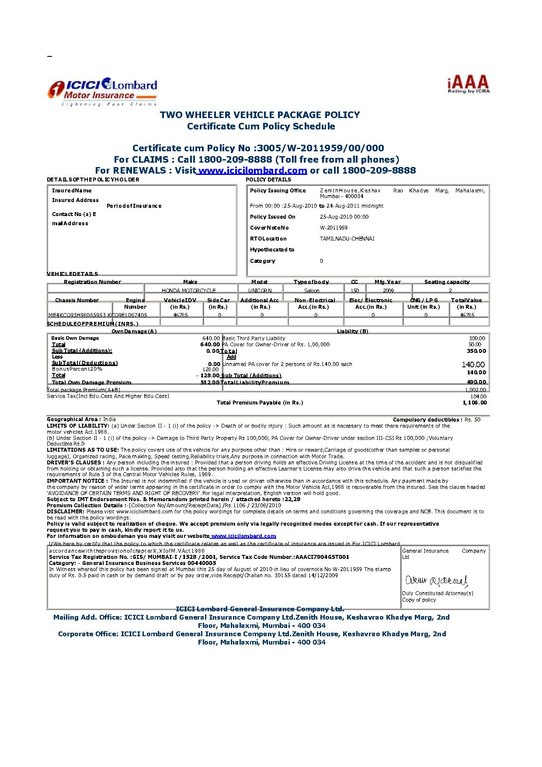
Image source: https://upload.wikimedia.org/wikipedia/commons/thumb/f/f2/Vehicle_Insurance_Certificate_in_India.pdf/page1-542px-Vehicle_Insurance_Certificate_in_India.pdf.jpg
A direct public offering ("Direct Public Offering") allows an issuer to sell its shares directly to investors. The Direct Public Offering involves registering securities with the Securities and Exchange Commission ("SEC") on a Form S-1 ("S-1") Registration Statement either on its own behalf in a primary offering or on behalf of its selling security holders in a secondary offering. All issuers qualify to register securities on Form S-1 and issuers who conduct direct public offerings often register their securities on Form S-1.which eliminates many of risks and expenses associated with reverse mergers and public shell companies including DTC Chills, Globa Locks and SEC trading suspensions.
Initial Public Offering
An initial public offering ("IPO") is where an investment banking firm assists an issuer with raising funds by selling securities that have been registered under the Securities Act of 1933, as amended (the "Securities Act"). Many issuers will not meet the income, asset, revenue or capital requirement standards that investment banking firms now have and will go public without the use of an underwriter.
Direct Public Offering
A Direct Public Offering ("Direct Public Offering") involves an issuer filing a registration statement with the SEC, typically on Form S-1 ("S-1) that registers shares from the issuer's treasury. Once the SEC declares the registration statement effective, the issuer then sells the registered securities directly to investors without the use of an underwriter.
SEC Review
After the issuer files the registration statement it is then subject to review by the SEC. After review of the registration statement the SEC may render comments which the issuer will address by filing amendments to its registration statement. When all of the SEC comments have been answered to the satisfaction of the SEC, it will declare the registration statement effective.
Getting a Ticker Symbol
Filing an S-1 registration statement under any of the above methods will not cause an issuer's securities to become publicly traded and it will not result in the assignment of a ticker symbol. After satisfying all the requirements of the SEC, the issuer then must comply with the requirements of the Financial Industry Regulatory Authority ("FINRA"), in order to obtain its ticker symbol.
Rule 15c211 and Establishing an Active Market
Generally, FINRA requires that the issuer have at least 25 shareholders who hold either registered shares or with respect to Pink Sheet listed issuers, shares that have been held by non-affiliate investors for twelve months. The majority of the 25 holders must have paid cash consideration for their shares. Additionally, these shares in the aggregate should represent at least 10% of the issuer's outstanding securities and are often referred to as the "Float." The Float must also be somewhat evenly distributed without significant concentration in one or a few shareholders. FINRA requires the issuers to locate a sponsoring market maker to file a Form 211 ("211"). For issuers who are non-reporting, audited financial statements are not required in order to file a 211. After the sponsoring market maker files a 211, FINRA reviews the 211 and provides comments for the sponsor to address. Upon receipt of confirmation that all comments have been answered satisfactorily, a ticker symbol is assigned and the issuers' securities are publicly traded.
By undertaking a Direct Public Offering, the issuer avoids many of the expenses and risk associated with reverse merger transactions. Reverse mergers are rarely done properly and have therefore become vehicles of fraud. Shell companies often have incomplete and sloppy records, pending lawsuits and other liabilities including securities violations. A common misconception exists that a reverse merger is a fast and certain method of becoming publicly traded. If proper due diligence is undertaken more often than not, the shell company will not pass scrutiny of a qualified SEC lawyer. Both FINRA and the SEC recently passed new requirements which create new hurdles issuers who engage in reverse mergers with public shell companies.
Upon completion of the reverse merger, under recently passed Rule 6490, the issuer is subject to a full review by FINRA which generally takes at least 30 days. FINRA has complete discretion of whether to approve corporate changes related to reverse mergers. Issuers going public direct with a Direct Public Offering have fewer hurdles to obtaining electronic trading from Depository Trust Company ("DTC"). Reverse merger companies often encounter DTC chills and global locks because of prior unregistered securities issuances and the public shells prior management. Owners of private companies are learning the hard way that reverse mergers can be a costly mistake. In reality, it is quicker and more cost effective to undertake a Direct Public Offering than to do a reverse merger.